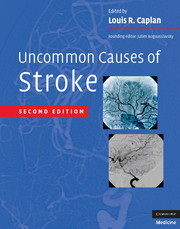Crossref Citations
This Book has been
cited by the following publications. This list is generated based on data provided by Crossref.
Gjerstad, Leif
and
Taubøll, Erik
2011.
The Causes of Epilepsy.
p.
565.
Sidorov, Evgeny V
Feng, Wuwei
and
Caplan, Louis R
2011.
Stroke in pregnant and postpartum women.
Expert Review of Cardiovascular Therapy,
Vol. 9,
Issue. 9,
p.
1235.
2011.
Acute Stroke Care.
p.
209.
2011.
The Causes of Epilepsy.
p.
113.
Wray, Shirley H.
and
Caplan, Louis R.
2012.
Stroke syndromes.
p.
98.
Uenaka, Takeshi
Hamaguchi, Hirotoshi
Sekiguchi, Kenji
Kowa, Hisatomo
Kanda, Fumio
and
Toda, Tatsushi
2013.
Reversible cerebral vasoconstriction syndrome in a stroke patient with systemic lupus erythematosus and antiphospholipid antibody.
Rinsho Shinkeigaku,
Vol. 53,
Issue. 4,
p.
283.
Lindgren, Arne
2014.
Stroke Genetics: A Review and Update.
Journal of Stroke,
Vol. 16,
Issue. 3,
p.
114.
Nakano, Tatsu
Yamaura, Genpei
Yokoyama, Mutsumi
Tanaka, Fumiaki
and
Koyama, Kazuo
2015.
A case of bilateral vertebral artery dissections presenting with abnormal behavior after surfing.
Nosotchu,
Vol. 37,
Issue. 1,
p.
47.
2015.
Vertebrobasilar Ischemia and Hemorrhage.
p.
29.
NOGAWA, Shigeru
2016.
Cancer-associated stroke—Clinical management of Trousseau's syndrome.
Japanese Journal of Thrombosis and Hemostasis,
Vol. 27,
Issue. 1,
p.
18.
Tipirneni, Anita
Koch, Sebastian
Romano, Jose G.
and
Malik, Amer M.
2016.
A 27-Year-Old Man With Right-Sided Hemiparesis and Dysarthria.
The Neurohospitalist,
Vol. 6,
Issue. 4,
p.
174.
Kalaria, Raj N.
2016.
Neuropathological diagnosis of vascular cognitive impairment and vascular dementia with implications for Alzheimer’s disease.
Acta Neuropathologica,
Vol. 131,
Issue. 5,
p.
659.
Amin, Hardik P.
and
Schindler, Joseph L.
2017.
Vascular Neurology Board Review.
p.
95.
2019.
Synopsis of Neurology, Psychiatry and Related Systemic Disorders.
p.
198.
Chowdhury, Farah N.
Chandrarathne, G. Sanjaya
Masilamani, Kristopher D.
LaBranche, Jennifer T. N.
Malo, Shaun
Svenson, Lawrence W.
Jeerakathil, Thomas
and
Vethanayagam, Dilini P.
2019.
Links Between Strokes and Hereditary Hemorrhagic Telangiectasia: A Population-Based Study.
Canadian Journal of Neurological Sciences / Journal Canadien des Sciences Neurologiques,
Vol. 46,
Issue. 1,
p.
44.
Kalaria, Raj N.
and
Hase, Yoshiki
2019.
Biochemistry and Cell Biology of Ageing: Part II Clinical Science.
Vol. 91,
Issue. ,
p.
477.
Falcone, Guido
and
Amin, Hardik P.
2020.
Vascular Neurology Board Review.
p.
123.
Horta, Erika
Burke-Smith, Conor
Megna, Bryant W.
Nichols, Kendall J.
Vaughn, Byron P.
Reshi, Rwoof
and
Shmidt, Eugenia
2022.
Prevalence of cerebrovascular accidents in patients with ulcerative colitis in a single academic health system.
Scientific Reports,
Vol. 12,
Issue. 1,
Hameed, Sajid
Karim, Nurose
Wasay, Mohammad
and
Venketasubramanian, Narayanaswamy
2024.
Emerging Stroke Risk Factors: A Focus on Infectious and Environmental Determinants.
Journal of Cardiovascular Development and Disease,
Vol. 11,
Issue. 1,
p.
19.



